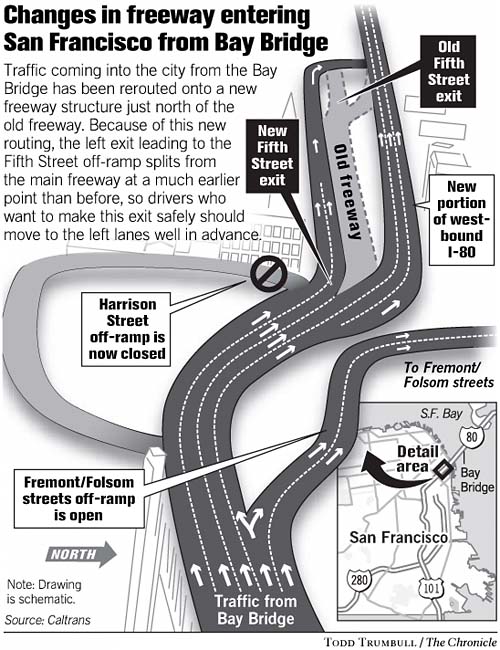Traffic was bad coming into San Francisco on the Bay Bridge Monday, and it will probably be bad again today -- and it will get a lot worse before it gets better.
When will it get better? In about four years, according to Caltrans. That's when a gigantic seismic upgrade project on the San Francisco end of the bridge will be finished.
The project, which entails replacing most of the San Francisco bridge ramps and freeway connections, is "really complex" said Caltrans spokesman Bart Ney. It's made even more complex because demolishing the old structures, and then building replacements has to proceed while the bridge is handling its usual load of 280,000 vehicles a day. It's a bit like performing bone surgery on someone while that person is at work on their regular job.
The result was a monumental traffic jam Friday morning and a lesser, but still impressive one Monday. The culprit seems to be a realignment of off-ramps from the upper deck leading into the city.
The Harrison Street off-ramp was shut down for the first time earlier in the week, causing backups, and then Friday the lanes leading to the Fifth Street off-ramp got a total realignment, producing a kind of domino effect, with cars, trucks and buses as dominoes.
Drivers, who often tackle the bridge on a kind of commuter automatic pilot, became confused at the changes. In the world of commuting, confusion becomes hesitation, and hesitation becomes a traffic jam.
It was bad enough at the Harrison Street off-ramp, but it got much worse at Fifth Street, where westbound traffic headed from Interstate 80 to Highway 101, had to make a kind of dogleg turn, right and then left.
Traffic heading to Fifth and Harrison Streets had to proceed down an off-ramp that went from two lanes to one and then headed into a single narrow lane bordered by white traffic barriers called K rail.
The effect was claustrophobic, as if freeway drivers had suddenly been shunted into something resembling an icy toboggan run at the winter Olympics.
"There's a large contingent of drivers who just totally freak out if you moved things by a millimeter, or if there's a new mild curve," said Marcus Pun of Oakland who was caught in Friday's jam. "They slow way down too much and cause a chain reaction." The same thing happened, Pun thinks, when Caltrans put metal plates at portions of the upper deck some months ago.
Drivers slowed up for no good reason. It was the unfamiliarity of it, Caltrans agrees. It was the change in alignment of the highway, not more traffic, or phases of the moon that caused the problems, Ney says.
"That's definitely it," Ney said.
Even AC Transit buses were affected Friday, when trips over the bridge took an hour. On Monday, said commuter Rose Heuning-Clark, the backup was smaller, but still impressive. She took a bus an hour earlier and still had some problems.
If the realignment is the problem, Ney thinks drivers will get used to the shape of the new roadway soon. But that won't last. Caltrans has two more alignment changes in store for the San Francisco end of the bridge, one in February, and one about a year from now.
Not only that, there is more in store -- and soon. As if roadway alignments weren't enough for westbound drivers on weekdays, Caltrans is now taking aim at weekend drivers, heading east out of the city.
Starting Saturday, crews will close either the First Street on-ramp, the Essex Street on-ramp or the Sterling Street on-ramp, leading to the lower deck of the bridge and heading to the East Bay on Saturday and Sunday for the next four weekends.
It has not been decided yet which ramps will be closed and for how long. The agency will pass the word at mid week. In addition, Caltrans is huddling with the San Francisco Giants, who have important games in September, to figure out how best to spread the pain.
All of this is necessary, Ney says, to demolish some of the old bridge approach ramps and rebuild the approaches to make the bridge safer in the event of earthquakes. Some of the ramps have been in place since the bridge opened nearly 69 years ago, and some of them have not been modified since major bridge reconstruction over 40 years ago.
When will all this be finished? "Early 2009," said Ney.
E-mail Carl Nolte at [email protected].
Page B-8
Changes in Freeway Entering San Francisco from Bay Bridge. Chronicle graphic by Todd Trumbull

|

